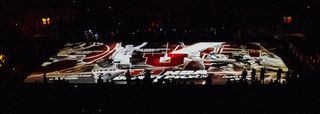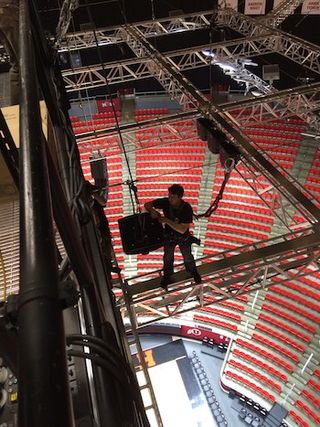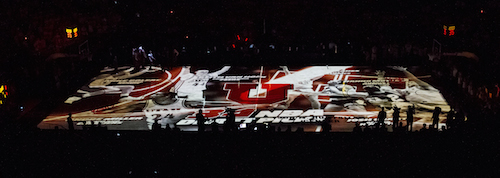The lights in the domed arena go dark as the eager fans murmur in expectancy. The anticipation builds. At once, the entire court is brilliantly illuminated—not by lights, but by the coruscating glow of ultra high definition video—and music fills the rafters.

The court of the Jon M. Huntsman Center is illuminated by 12 ASK Proxima projectors during a pre-game show.This is the scene before each game at the Jon M. Huntsman Center, the 15,000-seat home of the University of Utah basketball team. Last summer, the first phase of a major renovation began to revamp the lighting and sound in the 45-year-old arena. To add a professional touch to the game experience, the university decided to add a pre-game projection display to the list of upgrades.
The university chose Salt Lake City-based The Manhattan Project for the installation, which had equipped the university’s football training facilities with AV and projection.
To achieve the desired lumen output on the budget set by the university, The Manhattan Project decided to use ASK Proxima 3715 projectors, with 7,500 lumens each. “We installed 12 of those, and we divided them up into four quadrants,” said Matt Healy, custom electronic integrator at The Manhattan Project. “So we had three projectors in each quadrant that we stacked, and then blended all of the images together to create one image on the floor.”
According to Healy, getting all of the images to line up neatly was challenging. They had to get each of the three images in each quadrant perfectly aligned, then get all four quadrants lined up. “And the image ends up being 25 feet tall and 50 feet wide—each image—so if you move the lens just barely, the entire image is thrown off,” he said.

Crews from The Manhattan Project worked 85 feet above the floor to install the projection systems. But the real challenge—something Healy and his team had never faced before—was in the location of the work: 85 feet above the court, on a two-foot-wide metal-truss superstructure. “It was fairly intense up there,” Healy said. “I’m not used to working 85 feet off the floor. And we had to do everything from above, so everything had to be pulley-ed up into place.”
Beyond getting the 100-pound projectors hoisted up into the catwalk and properly aligned, which Healy estimated at 120 man-hours of work, the rest of the system was simpler than people might think, he said.
Healy and his team used a Gefen Dual Link DVI-over-fiber extender to send the video from a Mac Pro up to the projection array. They then installed an RGB Spectrum Media Wall Processor to divide the signal into four images, which were then sent to the projectors.
The result is a professional-caliber pre-game show that has had fans filling the building early. First used in a division matchup versus the University of Southern California on January 2, the show begins with effects that animate the floor into rippling tiles, followed by the illusion of the court crumbling into pieces. It then goes on to feature video highlights of the university’s proud basketball tradition, including its 34 players who have gone on to play in the NBA. During this part of the presentation, the video is split at the half-court line, with two different videos facing each side of the court.
- For a sports program that is beginning to find its stride—the Utah men’s basketball team made it into the Elite Eight round of the 2015 NCAA tournament before falling to national champion Duke—the bonus of playing in an arena with a professional entertainment experience will certainly enhance the university’s appeal to prospective student-athletes.
Watch a video of the pre-game show here.
Matt Pruznick is associate editor of SCN and Residential Systems.











